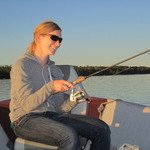The introduction of Pacific salmon to the Great Lakes in the 1960s is perhaps the best example of a government invasive species program that worked.
Following a century of destruction from overfishing, industrialization, deforestation, unregulated air and water pollution and a host of other environmental ills, the Great Lakes fisheries were in tough shape. Native fish species–lake trout, Michigan grayling, lake sturgeon, blue pike, lake whitefish, brook trout and others–were either extirpated or existed in remnant populations. Filling the ecological void were booming populations small, nonnative fish–the alewife and the rainbow smelt. Another nonnative, the predatory sea lamprey, led to the demise of lake trout and thwarted their recovery.
Introducing coho salmon to Lake Michigan was somewhat of a Hail Mary strategy. Biologists knew these ocean fish could survive in a freshwater environment and hoped they would eat the abundant alewives. What the biologists couldn’t have known was how successful salmon would become and how much excitement the new fishery would generate with the public. Salmon fever swept throughout the Great Lakes during the 1970s and 80s, transforming lakeside tourism and edging the lakes away from their industrial past.
Today, few would argue that Great Lakes salmon stocking was a conservation triumph, which is ironic. Now fisheries biologists are reluctant to introduce non native fish into new environments. Instead we worry about the real and imagined consequences of new invasive species entering our waters.
Nearly 50 years later, maintaining salmon in the Great Lakes remains a largely artificial endeavor requiring hatcheries to propagate fish for annual stockings. Lake Superior is an exception, because it is blessed with an abundance of cold tributary streams where salmon can spawn. Superior is also the only lake where native lake trout have recovered as a self-sustaining population. In the other four lakes, lake trout, like salmon, are largely supported through stocking.
Perhaps there is a lesson here. Even though the salmon introduction was successful, we still haven’t found a way to fix what was broken with the Great Lakes native fishery. If the hatcheries closed tomorrow, lakes other than Superior would slowly revert to their pre-salmon condition as the large predator fish disappeared and less desirable species became more abundant to fill the void. In yet another irony, we need artificial salmon and trout stockings to maintain some semblance of a natural balance.
This situation is not unique to the Great Lakes. Wherever the heavy hand of human use has significantly altered the landscape, native fish and wildlife have either adapted to habitat changes or disappeared. As populations of native species diminish, very often non native species take their place. An example is the ring-necked pheasant, an Asian bird adapted to an agricultural environment. Pheasants were introduced to the American West over 100 years ago, at the same time the endless prairie grasslands were broken by the plow. As farming dominated the landscape, the pheasant gained dominance over native prairie grouse. Without vast grasslands, those native grouse can’t survive. It is not an accident the pheasant is the state bird of South Dakota, a state also known for its iconic Corn Palace.
Many of the creatures we take for granted came from somewhere else and thrive here because human activity created a habitat niche for them. A recent arrival is the wild turkey, which artificial introductions have allowed to quickly spread throughout suitable habitat in the state. Although native to North America, there are scant historical records of their existence in Minnesota. In contrast, the Canada goose is a native bird that recovered from overhunting in the pioneer era and adapted to an altered landscape that includes lakeside lawns well suited to grazing geese.
Non natives in our waters even include the walleye, our state fish. Both walleyes and smallmouth bass were introduced to many lakes to provide fishing opportunities. While fish managers have saturated the state’s waters with those species, they continue introducing muskiesto new waters. Brown and rainbow trout also were widely introduced to suitable lakes and streams.
Most of our introduced fish and game species have been around so long that few but the oldest Minnesotans can remember what it was like before they arrived. The same is true of our most pervasive nuisance species, such as the common carp, the English sparrow, the sea lamprey or the starling. Like the Great Lakes salmon, all of them found a niche in an altered natural environment. Some introduced species, like the carp and sea lamprey, continue to wreak havoc on the environment and require ongoing population and damage control efforts. Again, human intervention is necessary to strike a semblance of natural balance.
While we’ve made strides at reducing air and water pollution, we generally protect fish and wildlife habitat only when it is convenient or profitable to do so. Profound alterations to the landscape continue to occur, from plowing up millions of acres of grass to grow more grain to bulldozing natural shorelines to build lakeshore homes. While we take these human endeavors for granted, few of us seem to consider the obvious—whatever critters existed previously on that land no longer have a home. Since Nature abhors a vacuum, it’s inevitable other creatures, perhaps less desireable ones, will take their place.
As long as we continue to use the landscape primarily for human benefit, we will be faced with an ever-changing natural world where new species appear to take the place of those unable to adapt to altered habitat. And by doing so, we will continue opening the door to new invasive species. Perhaps, in our increasing strident attempts to control invasive species, we should come to terms with fact that an altered ecosystem is like a person with a compromised immune system—it’s natural defenses are weakened or eliminated. Our failure to do so is perhaps the greatest of invasive ironies.




